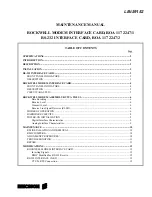
ROCKWELL MODEM INTERFACE CARD
LBI-39152
5
NOTE
The numbers shown in parentheses refer to the
circuit diagram’s reference designator.
+5V
The +5 volt Indicator,
+5V
(V1), is ON during normal
operation indicating fuse F1 is good and +5 Vdc (V
CC
) is
being applied to the module circuitry.
+12V
The +12 volt Indicator,
+12V
(V2), is ON during
normal operation indicating fuse F3 is good and +12 Vdc
(V
DD
) is being applied to the module circuitry.
-12V
The -12 volt Indicator,
-12V
(V3), is ON during normal
operation indicating fuse F3 is good and -12 Vdc (V
SS
) is
being applied to the module circuitry.
RLSD
The Received Line Signal Detect indicator,
RLSD
(V12), is ON. when the received line power is greater than
the selected threshold level at the end of the training state
and the receiver is in the data state. When the indicator is
off, the received signal power is less than the selected
threshold level at the end of the training state and the
receiver is in the idle state.
CTS
The Clear To Send indicator,
CTS
(V11), is turned ON
by the Rockwell Modem after it receives an RTS, telling the
processor that the modem is set up and data may be sent.
DESCRIPTION
The RMIC is controlled by its corresponding Digital
Receivers or Selector and provides a high speed
synchronous serial interface between EDACS components in
the Voter, Main Site, and remote Receiver Stations. In
addition, the Selector sends and receives data from the Main
Site through the modem interface. The data transfer rate is
typically 9600 bits per second (bps) using conditioned 3002
four-wire telephone lines.
The telephone line transformers T1 and T2, couple the
four-wire telephone line to the RMIC.
The RM demodulates the incoming analog signal which
comes from phone lines via T1 and converts it to TTL 9600
baud data. A TTL to RS-232 converter on the RMIC
converts the data to RS-232 levels and sends it to the
Selector or Digital Receiver for processing.
An RS-232 9600 baud transmit data signal comes from
the Selector and is converted to TTL in the RMIC. The RM
converts this data into an analog signal which can be carried
by phone line. The analog signal is buffered on the RMIC
and applied via T2 to the phone line.
CIRCUIT ANALYSIS
The Digital Receiver or Selector's General Purpose
Trunking Card (GPTC) interface to the 9600 baud RMIC
through the VME Shelf Backplane. The microcomputer
(U1) on the Selector or Digital Receiver provides transmit
and receive data to the RM via the Phone Modem (U32) on
the GPTC. Refer to the Block Diagram in Figure 3.
Receive
Transformer T1 receives data from the telephone line
and couples the data to the modem board at X2 pin 33. A
voltage follower (U4-1) drives the data to the RM. Gain
Switch S1-5 thru S1-8 sets the telephone line level to the
proper modem level. The receive level is normally set to
300 mV at U4 pin 7 (X2 pin 33) by closing the one section
of switch S1 sections 5 thru 8 which sets the level closest to
300 mV. Regulator diodes V4 and V5 provide surge
protection.
The Write Pulse Generation circuit timer U3 generates a
very slow square wave with a period of 2 minutes when
monitored at U3 pin 3. On each negative edge to U1 pin 5,
a 2 microsecond positive going pulse is generated at U1 pin
6. This pulse is inverted by V8 and is applied to the WRITE
input of the RM (X1 pin 12). This causes fixed data on the
D0 thru D7 inputs to be written into the RM Control
Register addressed by RS0 thru RS3. This assures that the
RM is always initialized and runs in the desired mode.
As long as the RM sees data coming in, the
RSLD
LED
will be ON. In voter applications, all data is continuous, so
the
RSLD
LED should be ON all the time.
The receiver data (RXD) passes unchanged through
XOR gate U2-0 and is converted from TTL to RS-232 by
U5. The receiver data (MRXD) is then sent to the GPTC
Phone Modem U32 and transferred to the BD Bus and
processed by the GPTC microcomputer U1.
Transmit
In voter applications, RTS is controlled by the Selector
and jumper X7 should be on X3 pins 2 & 3. When data is to
be sent, the GPTC microcomputer sends a Request-to-Send
(RTS) signal to the RMIC and waits for a Clear-to-Send
(CTS) signal from the modem board. The RTS signal is
converted from RS-232 to TTL by U5 and sent on to the
Rockwell Modem. When the Rockwell Modem is ready, a
CTS signal is sent. Front panel indicator V11 is illuminated
NOTE




















